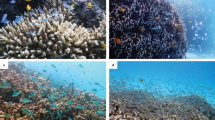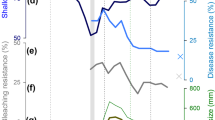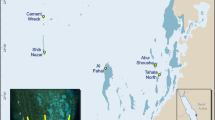Abstract
CORALS may be harmed by their natural enemies or by environmental conditions. The ability of scleractinian corals to regenerate damaged parts has been documented qualitatively by many investigators1–10, but detailed quantitative data on the rate of regeneration have not been reported. Most reports dealing with the destruction of coral reefs have emphasised the long time required for recovery11. I have found, however, that the rate of skeletal regeneration in a population of the branched coral Stylophora pistillata (Esper) is surprisingly fast. During the first 2 months of regeneration, damaged colonies grew twice as fast as intact control colonies. Within the same colony, damaged branches grew faster than intact branches, which resulted in a tendency to regain symmetry lost through breakage. Larger colonies showed a better capacity to resist damage than smaller colonies.
This is a preview of subscription content, access via your institution
Access options
Subscribe to this journal
Receive 51 print issues and online access
$199.00 per year
only $3.90 per issue
Buy this article
- Purchase on Springer Link
- Instant access to full article PDF
Prices may be subject to local taxes which are calculated during checkout
Similar content being viewed by others
References
Wood-Jones, F., Proc. zool. Soc. Lond., 518–556 (1907).
Edmonson, C. H., Bull. Bernice P. Bishop Mus., 58, 1–38 (1929).
Stephenson, T. A., and Stephenson, A., Sci. Rep. Gt Barrier Reef Exped., 3, 167–217 (1933).
Kawaguti, S., Palao trap. biol. Stn Stud., 1, 209–216 (1937).
Kawakami, I., Palao trop. biol. Stn Stud., 2, 147–156 (1941).
Stephenson, W., Endean, R., and Bennett, I., Aust. J. mar. Freshwat. Res., 9, 261–318 (1958).
Franzisket, L., Int. Revue gea. Hydrobiol, 55, 1–12 (1970).
Fishelson, L., Mar. Biol., 19, 183–196 (1973).
Maragos, J. E., thesis, Univ. Hawaii (1972).
Shinn, E. A., Coral Reef Recovery in Florida and in the Persian Gulf (Environment Conservation Department, Shell Oil Co., Houston, Texas, 1972).
Stoddart, D. R., Biol. Rev., 44, 433–498 (1969).
Loya, Y., and Slobodkin, L. B., in Regional Variation in Indian Ocean Coral Reefs (edit. by Yonge, M., and Stoddart, D. R.), 28, 117–139 (Academic, London and New York, 1971).
Loya, Y., Mar. Biol., 13, 100–123 (1972).
Loya, Y., Nature, 259, 478–480 (1976).
Connell, J. H., in Biology and Geology of Coral Reefs, 2 (edit. by Jones, O. A., and Endean, R.), 205–245 (Academic, New York and London, 1974).
Roos, P. J., Growth and Occurrence of the Reef Coral Porites astreoides Lamarck in Relation to Submarine Radiance Distribution (Drukkerij Elinkwijk, Utrecht, 1967).
Pearse, V. B., and Muscatine, L., Biol. Bull, 141, 350–363 (1971).
Author information
Authors and Affiliations
Rights and permissions
About this article
Cite this article
LOYA, Y. Skeletal regeneration in a Red Sea scleractinian coral population. Nature 261, 490–491 (1976). https://doi.org/10.1038/261490a0
Received:
Accepted:
Issue Date:
DOI: https://doi.org/10.1038/261490a0
This article is cited by
-
Differing lesion recovery rates of two Caribbean stony coral species across a shallow water to mesophotic depth gradient suggest different sensitivity to repeated disturbance
Coral Reefs (2023)
-
Energy depletion and opportunistic microbial colonisation in white syndrome lesions from corals across the Indo-Pacific
Scientific Reports (2020)
-
Temporal consistency in background mortality of four dominant coral taxa along Australia’s Great Barrier Reef
Coral Reefs (2016)
-
Effect of sub-lethal damage to juvenile colonies of massive Porites spp. under contrasting regimes of temperature and water flow
Marine Biology (2010)
-
Using three-dimensional surface area to compare the growth of two Pocilloporid coral species
Marine Biology (2008)
Comments
By submitting a comment you agree to abide by our Terms and Community Guidelines. If you find something abusive or that does not comply with our terms or guidelines please flag it as inappropriate.



